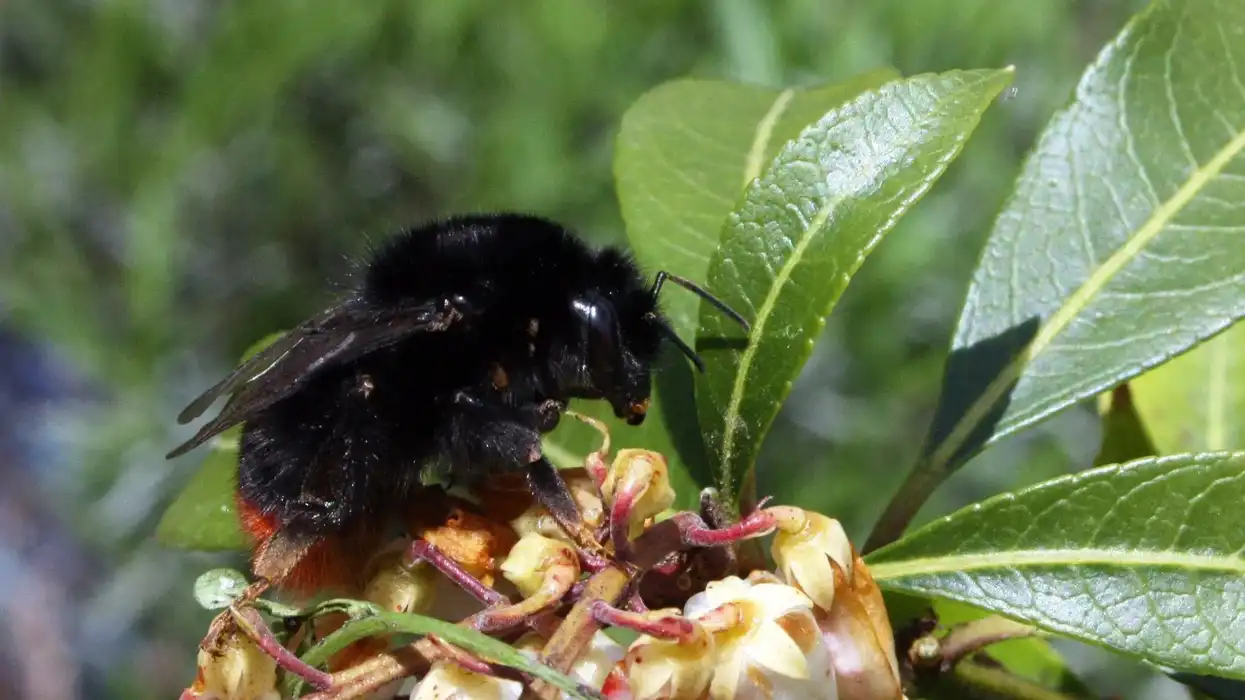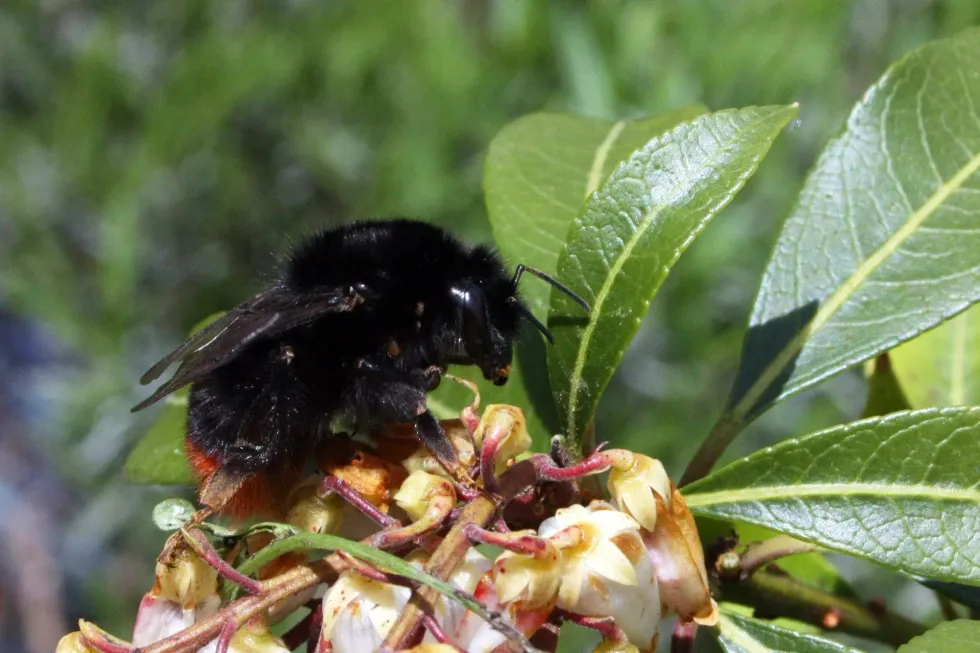Do you like bumblebees, like the tree bumblebee? Then here we have all the information on the red-tailed bumblebee.
The red-tailed bumblebee (Bombus lapidarius) is a species of bumblebee that can be found quite commonly in Central Europe. This species prefers to live in an open habitat range, like meadows, gardens, pastures, grasslands, and more.
These bumblebees can be distinguished easily because they have a red tail. The queens and the workers have a uniform black body with an orange-red tail. Only the males have more yellow bands or hairs on its body along with an orange-red tail.
These bumblebees are a species of Least Concern, but it has been observed that climate change is affecting them, so their population fluctuates now and then. The good news is, these little wonderful things are quite persistent and their population shows a rather increasing trend.
If you like this article, then get involved by reading green lacewing facts and thread-waisted wasp facts.
Red-Tailed Bumblebee Interesting Facts
What type of animal is a red-tailed bumblebee?
The red-tailed bumblebee (Bombus lapidarius) is a species of bee, specifically a bumblebee.
What class of animal does a red-tailed bumblebee belong to?
The red-tailed bumblebee belongs to the class Insecta of animals.
How many red-tailed bumblebees are there in the world?
The population of red-tailed bumblebees (Bombus lapidarius) in an exact number is not known. They have been observed to be common within their range, but their population fluctuates throughout the year. Their population is showing an increasing trend and their population is extending northwards in Scotland.
Where does a red-tailed bumblebee live?
The geographic range of this species of bee is pretty widespread. They are one of the most common species of bumblebee spread across central Europe.
To the east, they are found up to the 60th parallel in the Russian plains and the border might reach the south of the Ural Mountain, Orenburg. To the west, they live in Ireland and in the Cantabrian Mountains.
To the south, they are found commonly until the 45th parallel and they become an alpine and montane species further southwards.
To the north, they are common until the Arctic Circle in Sweden and Finland and they become uncommon further northwards as the latitude of Stockholm crosses. To the southwest, they have been seen in the mountains of Armenia and Georgia, north Anatolia, and in the Caucasus.
What is a red-tailed bumblebee's habitat?
The primary red-tailed bumblebee habitat is various kinds of open habitats. They can get involved in roadsides, cliff sites, meadows, coastal dunes, gardens, calcareous grasslands, and pastures. The population of this species that live in the southern range has also been observed to live in open forests and woodlands.
Who does the red-tailed bumblebee live with?
This species of bumblebees are social in nature, like most other species of bees. 100-200 of these bees live together in a colony. At the top of the colony, hierarchy is the queen red-tailed bumblebee, new queens, then the males, and finally the workers.
How long does a red-tailed bumblebee live?
The lifespan of red-tailed bumblebees (Bombus lapidarius) is not known. However, the lifespan of bumblebees, in general, depends on their position in their colony hierarchy. The bumblebee workers live for only about 12-28 days. The queens can live for 18-19 weeks and even up to 24 weeks at times. Most of the time the queen outlives her colony.
How do they reproduce?
The breeding season of this species of bumblebees begins as the queen red-tailed bumblebees emerge from their hibernation. The queen emerges from hibernation in spring, around March. The workers have been observed to appear around May and the males appear around June.
After the queen emerges, she lays her eggs. The eggs then hatch and they become the workers. These workers tend to the nest.
Males then appear after that. Males are also known as drone bees because as soon as they emerge from their hibernation, they start to look for new potential queens to mate.
These potential queens are usually new queen bumblebees. After mating, the males and the queen will probably die during the autumn. Whereas, the new queens or prospective queens go to hibernate and repeat the cycle again once they wake up the following spring.
What is their conservation status?
The conservation status of the red-tailed bumblebees (Bombus lapidarius) according to the International Union for Conservation of Nature is listed as of Least Concern. They don't have many great threats other than climate change.
Climate change has been causing fluctuations in their population. They occur in protected areas and they have also been included in the National Red Data Book of Ireland for preservation efforts.
Red-Tailed Bumblebee Fun Facts
What does the red-tailed bumblebee look like?

The appearance of red-tailed bumblebees (Bombus lapidarius) depends on their position in their social hierarchy. The queen is the longest in size and not heavy. They have an entirely black body with bright orange-colored or red hairs on their tail on either side of pollen baskets.
The worker bumblebees are the smallest. They are as small as houseflies and have the same colors as the queen bumblebees. The males look similar to the queen and the workers but have a little more orange-yellow bands or hairs on their bodies.
How cute are they?
Red-tailed bumblebees (Bombus lapidarius) have an adorable look to them, but many people are afraid of bees and bumblebees. The male bumble bees look similar to the queen and the workers but have a little more orange-yellow bands or hairs on their bodies.
However, red-tailed bumblebee aggressive nature has not been recorded without a reason. They will only attack if they are threatened in any way, so try to admire them from a distance.
How do they communicate?
Bumblebees, in general, don't dance to communicate with each other like other bees. They rather communicate through chemical means, like pheromones and the vibration created from the fluttering of their wings to communicate with each other.
They mainly communicate with each other to mate. Unlike other bees, they don't communicate the locations of flowers to each other. Bumblebees find their own food themselves.
How big is a red-tailed bumblebee?
The worker red-tailed bumblebee size is about 0.4-0.6 in (1.1-1.6 cm), the males are about 0.5-0.6 in (1.4-1.6 cm), and the queens are about 0.8-0.9 in (2-2.2 cm) in length. The wingspan of the workers and the males are about 0.5 in (1.2 cm) and the queens are about 0.7 (1.7 cm).
They are slightly smaller than American bumblebees, who are about 0.5-1.0 in (1.3-2.6 cm) in length.
How fast can a red-tailed bumblebee fly?
The exact speed at which the Bombus lapidarius fly is not known. However, bumblebees, in general, can reach the speed of 6.7-10 mph (10.8-16 kph).
How much does a red-tailed bumblebee weigh?
The exact weight of a Bombus lapidarius is not known. However, bumblebees, in general, weigh about 0.0003-0.0004 lb (136-181 mg) on average.
What are the male and female names of the species?
The males and the females of the species have no specific names.
What would you call a baby red-tailed bumblebee?
Bombus lapidarius babies are called larvae. As the eggs of these bumblebees hatch, they are called larvae, then they become pupae and finally adults.
What do they eat?
These bumblebees have short tongues, so they search for flowers that have landing platforms, such as thistles, dandelions, or daisies. These flower heads are usually made up of many small florets.
These bumblebees don't hover over these flowers, they walk around these flowers to collect nectar.
These small florets contain very little amount of nectar, so the bumble bees probe many times to collect low amounts of nectar each time, but with minimal energy and time. Males don't have pollen baskets, only females have pollen baskets, so only females gather pollen in these pollen baskets.
Are they dangerous?
Bumblebees are dangerous or aggressive towards humans or otherwise without any reason. They will not sting unless they are threatened in some way. However, if they sting, they will not die, unlike hive bees.
Hive bees leave their sting when they attack their victims. That doesn't happen with bumblebees, so if they do sting you once, they might come back to sting you another time. The red-tailed bumblebee sting might not endanger your life, but you should try to stay at a distance from them.
Would they make a good pet?
Bumblebees are social insects and stay in a colony with each of them fulfilling their duties. The queens are the most fertile and they are there to lay eggs, the workers tend to the nest and hatched larvae, while the males are there to mate.
They live best as a part of their colony, so it's better to not take them away from their natural habitat. This gives them the best chance at survival.
Did you know...
Red-tailed bumblebee digging habits are natural as they build their nests in an old burrow in the ground or under stones.
The queen has an entirely black body with bright orange-colored or red hairs on their tail on either side of pollen baskets. The male bumblebee looks similar to the queen and the workers but has a little more orange-yellow bands or hairs on their bodies.
The males also have red hairs located on the hind tibiae unlike the queen that has red hairs on their tails and pollen baskets.
What kind of bees has a red bottom?
Some other species of bumble bees that have red bottoms similar to red-tailed bumblebees (Bombus lapidarius) are early bumblebees, bilberry bumblebees, red-shanked bumblebees (Bombus ruderarius), and red-tailed cuckoo bumblebees (Bombus rupestris). Early and bilberry bumblebees are most different from these five.
Early and bilberry bumblebees have more yellow bands on their bodies. Early bumblebees have wider yellow bands than bilberry bumblebees.
Similar to red-tailed bumblebees, red-shanked bumblebee (Bombus ruderarius) and red-tailed cuckoo bumblebee (Bombus rupestris) don't possess yellow bands. Other than males of red-tailed cuckoo bumblebee (Bombus rupestris) and red-tailed bumblebees, all the red-tailed bumblebees, red-shanked bumblebees (Bombus ruderarius), and red-tailed cuckoo bumblebees have a uniform black body with red bottoms.
What flowers do red-tailed bumblebees like?
Red-tailed bumblebees (Bombus lapidarius) have short tongues, so they prefer flowers where they can land properly. They prefer flowers, like thistles, dandelions, or daisies.
These kinds of flowers have a lot of small florets on their heads which contain small amounts of nectar. These bumblebees walk around on the flower heads to probe and collect that nectar from the florets for their menu.
Here at Kidadl, we have carefully created lots of interesting family-friendly animal facts for everyone to discover! For more relatable content, check out these tree bumblebee facts and lychee stink bug facts.
You can even occupy yourself at home by coloring in one of our free printable white-tailed bumblebee coloring pages.
Both images by Charles J. Sharp









